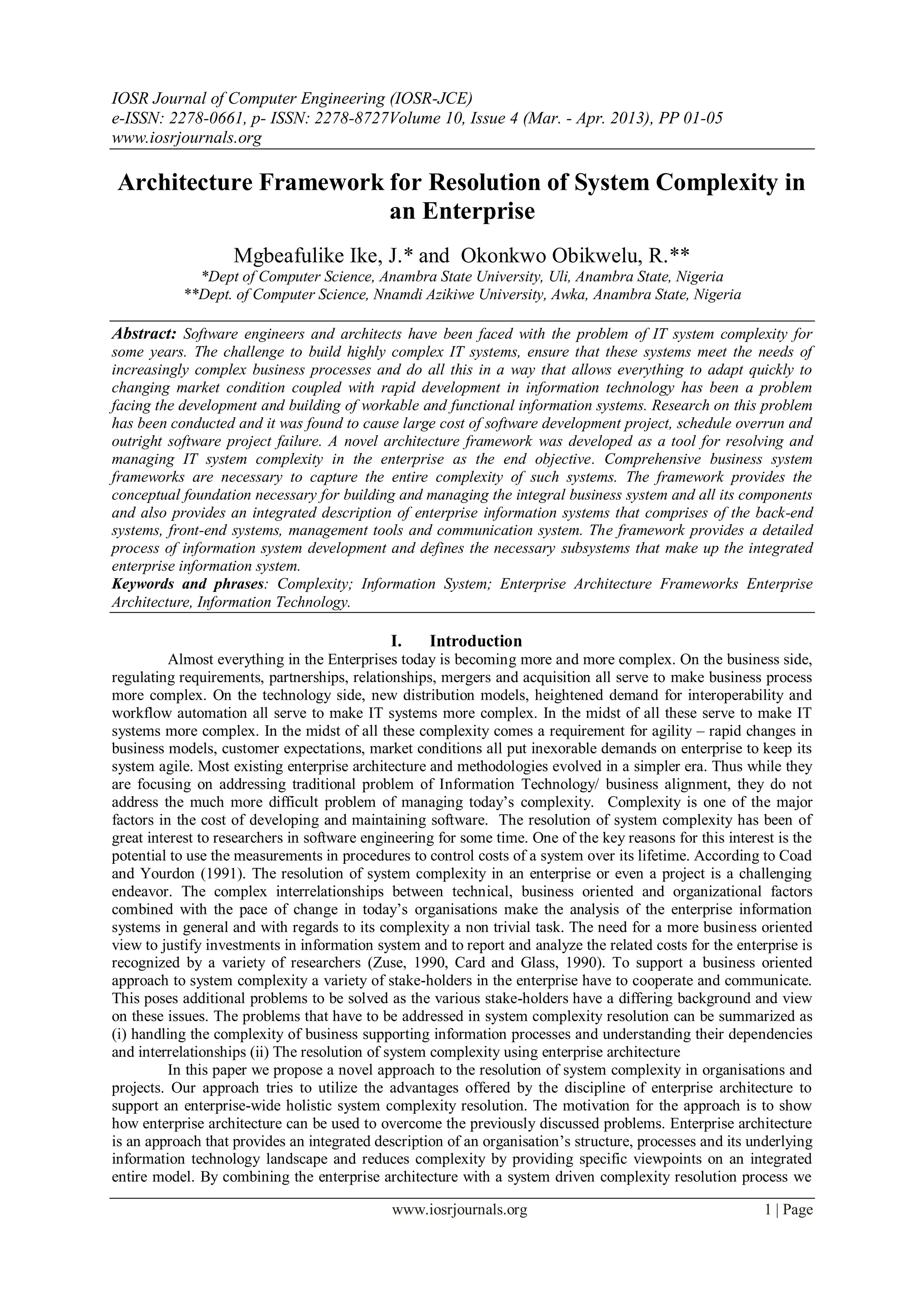This document presents an architecture framework for resolving system complexity in an enterprise. It discusses how enterprise architecture can be used to address issues like requirement complexity, organizational complexity, process complexity, and design complexity. The framework breaks down the enterprise information system into subsystems like back-end systems, front-end systems, management tools, and communication systems. It also separates concerns into different architecture layers - an external enterprise model, conceptual enterprise model, front-end systems, back-end systems, and management tools. The framework is intended to provide a structured approach to managing complexity by organizing enterprise data and functions across the different systems and models.




![Architecture Framework For Resolution Of System Complexity In An Enterprise
www.iosrjournals.org 5 | Page
Management Tools
Management tools are applications used to support management activities in all levels of the
organisation. Management tools include applications such as operational data stores, analytics, data warehouse,
business intelligence applications, budgeting and reporting, Knowledge Bases and Knowledge-Based Systems.
These applications are often integrated with backend, front end and engineering applications and they collect
data from these applications and refine it as useful information. Communication systems are used for
collaboration and communication within the company and with external parties. Communication applications
include applications such as e-mail and groupware.
V. Conclusion
Advance in development and rapid technological innovations with software crisis has been identified as
being major contributing factors to IT system complexity. The enterprise architecture in this case becomes very
useful in the aspect of managing system complexity by structuring data in a common language and format.
Complex information system development intentions often result in a large number of outright failures which
are sometimes economical such as budget and schedule overruns. Also due to poor product quality and
insufficient user satisfaction, the information system faces great challenges. It is only by adopting enterprise
architecture can enterprises be able to manage this complex system situation. Enterprise architecture is a
blueprint of an organization’s vision and a management framework that includes various business methods and
tools to understand and document the structure of an enterprise, and help the enterprise to organize its business
processes and Information Systems (IS) / Information Technology (IT) resources to achieve strategic alignment
between its business processes and IS/IT capabilities.
References
[1]. Oracle (2009). An Oracle White Paper in Enterprise Architecture October.
[2]. Booch G (2005). “The Complexity of Programming Models”. Keynote talk at AOSD 2005, Chicago, Il, March 14-18, 2005.
[3]. Card D. N. and R. L. Glass (1990., Measuring Software Design Quality, Englewood Cliffs, NJ:Prentice Hall.
[4]. Coad P. and E. Yourdon (1991). Object-Oriented Design, Englewood Cliffs, NJ:Prentice Hall.
[5]. Chan, J.O (2004). The Analytic Enterprise Model for the Value Chain. Communications of the International Information Management
Association, 4(4), 59-69.
[6]. Chan, J.O (2008). An Integrated Architecture for Enterprise Relations Management. Communication of International Information
Management Association, 8(2), 55-66.
[7]. DoD Architecture Framework Working Group. DoD Architecture Framework, Feb 2004.
[8]. Kemal A. Delic (2002) .Enterprise It Complexity Zuse H. (1990). Software Complexity Measures and Models, New York, NY: de
Gruyter & Co.](https://image.slidesharecdn.com/a01040105-140429000907-phpapp01/75/Architecture-Framework-for-Resolution-of-System-Complexity-in-an-Enterprise-5-2048.jpg)